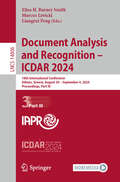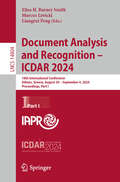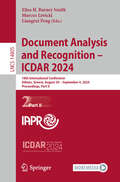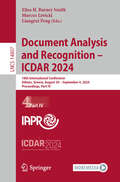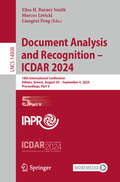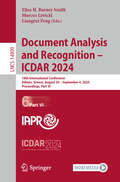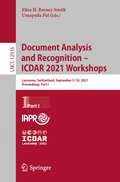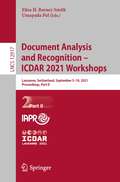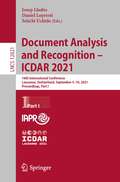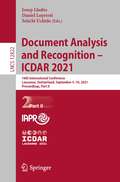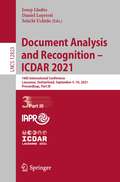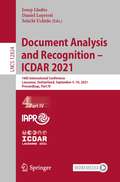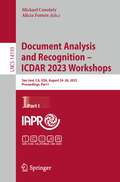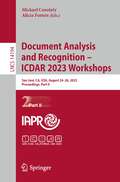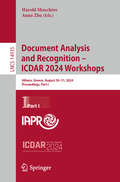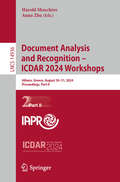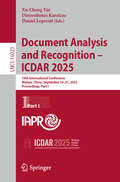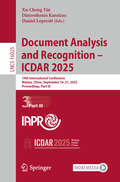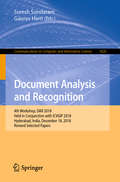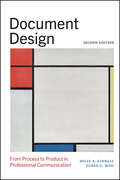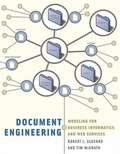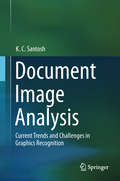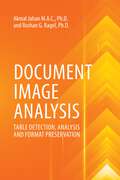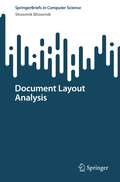- Table View
- List View
Document Analysis and Recognition - ICDAR 2024: 18th International Conference, Athens, Greece, August 30 – September 4, 2024, Proceedings, Part III (Lecture Notes in Computer Science #14806)
by Elisa H. Barney Smith Marcus Liwicki Liangrui PengThis six-volume set LNCS 14804-14809 constitutes the proceedings of the 18th International Conference on Document Analysis and Recognition, ICDAR 2024, held in Athens, Greece, during August 30–September 4, 2024. The total of 144 full papers presented in these proceedings were carefully selected from 263 submissions. The papers reflect topics such as: document image processing; physical and logical layout analysis; text and symbol recognition; handwriting recognition; document analysis systems; document classification; indexing and retrieval of documents; document synthesis; extracting document semantics; NLP for document understanding; office automation; graphics recognition; human document interaction; document representation modeling and much more.
Document Analysis and Recognition - ICDAR 2024: 18th International Conference, Athens, Greece, August 30–September 4, 2024, Proceedings, Part I (Lecture Notes in Computer Science #14804)
by Elisa H. Barney Smith Marcus Liwicki Liangrui PengThis six-volume set LNCS 14804-14809 constitutes the proceedings of the 18th International Conference on Document Analysis and Recognition, ICDAR 2024, held in Athens, Greece, during August 30–September 4, 2024. The total of 144 full papers presented in these proceedings were carefully selected from 263 submissions. The papers reflect topics such as: Document image processing; physical and logical layout analysis; text and symbol recognition; handwriting recognition; document analysis systems; document classification; indexing and retrieval of documents; document synthesis; extracting document semantics; NLP for document understanding; office automation; graphics recognition; human document interaction; document representation modeling and much more.
Document Analysis and Recognition - ICDAR 2024: 18th International Conference, Athens, Greece, August 30–September 4, 2024, Proceedings, Part II (Lecture Notes in Computer Science #14805)
by Elisa H. Barney Smith Marcus Liwicki Liangrui PengThis six-volume set LNCS 14804-14809 constitutes the proceedings of the 18th International Conference on Document Analysis and Recognition, ICDAR 2024, held in Athens, Greece, during August 30–September 4, 2024. The total of 144 full papers presented in these proceedings were carefully selected from 263 submissions. The papers reflect topics such as: document image processing; physical and logical layout analysis; text and symbol recognition; handwriting recognition; document analysis systems; document classification; indexing and retrieval of documents; document synthesis; extracting document semantics; NLP for document understanding; office automation; graphics recognition; human document interaction; document representation modeling and much more.
Document Analysis and Recognition - ICDAR 2024: 18th International Conference, Athens, Greece, August 30–September 4, 2024, Proceedings, Part IV (Lecture Notes in Computer Science #14807)
by Elisa H. Barney Smith Marcus Liwicki Liangrui PengThis six-volume set LNCS 14804-14809 constitutes the proceedings of the 18th International Conference on Document Analysis and Recognition, ICDAR 2024, held in Athens, Greece, during August 30–September 4, 2024. The total of 144 full papers presented in these proceedings were carefully selected from 263 submissions. The papers reflect topics such as: document image processing; physical and logical layout analysis; text and symbol recognition; handwriting recognition; document analysis systems; document classification; indexing and retrieval of documents; document synthesis; extracting document semantics; NLP for document understanding; office automation; graphics recognition; human document interaction; document representation modeling and much more.
Document Analysis and Recognition - ICDAR 2024: 18th International Conference, Athens, Greece, August 30–September 4, 2024, Proceedings, Part V (Lecture Notes in Computer Science #14808)
by Elisa H. Barney Smith Marcus Liwicki Liangrui PengThis six-volume set LNCS 14804-14809 constitutes the proceedings of the 18th International Conference on Document Analysis and Recognition, ICDAR 2024, held in Athens, Greece, during August 30–September 4, 2024. The total of 144 full papers presented in these proceedings were carefully selected from 263 submissions. The papers reflect topics such as: document image processing; physical and logical layout analysis; text and symbol recognition; handwriting recognition; document analysis systems; document classification; indexing and retrieval of documents; document synthesis; extracting document semantics; NLP for document understanding; office automation; graphics recognition; human document interaction; document representation modeling and much more.
Document Analysis and Recognition - ICDAR 2024: 18th International Conference, Athens, Greece, August 30–September 4, 2024, Proceedings, Part VI (Lecture Notes in Computer Science #14809)
by Elisa H. Barney Smith Marcus Liwicki Liangrui PengThis six-volume set LNCS 14804-14809 constitutes the proceedings of the 18th International Conference on Document Analysis and Recognition, ICDAR 2024, held in Athens, Greece, during August 30–September 4, 2024. The total of 144 full papers presented in these proceedings were carefully selected from 263 submissions. The papers reflect topics such as: document image processing; physical and logical layout analysis; text and symbol recognition; handwriting recognition; document analysis systems; document classification; indexing and retrieval of documents; document synthesis; extracting document semantics; NLP for document understanding; office automation; graphics recognition; human document interaction; document representation modeling and much more.
Document Analysis and Recognition – ICDAR 2021 Workshops: Lausanne, Switzerland, September 5–10, 2021, Proceedings, Part I (Lecture Notes in Computer Science #12916)
by Elisa H. Barney Smith Umapada PalThis book constitutes the proceedings of the international workshops co-located with the 16th International Conference on Document Analysis and Recognition, ICDAR 2021, held in Lausanne, Switzerland, in September 2021.The total of 59 full and 12 short papers presented in this book were carefully selected from 96 contributions and divided into two volumes. Part I contains 29 full and 4 short papers that stem from the following meetings: ICDAR 2021 Workshop on Graphics Recognition (GREC); ICDAR 2021 Workshop on Camera-Based Document Analysis and Recognition (CBDAR); ICDAR 2021 Workshop on Arabic and Derived Script Analysis and Recognition (ASAR 2021); ICDAR 2021 Workshop on Computational Document Forensics (IWCDF). The main topics of the contributions are document processing; physical and logical layout analysis; text and symbol recognition; handwriting recognition; signature verification and document forensics, and others.
Document Analysis and Recognition – ICDAR 2021 Workshops: Lausanne, Switzerland, September 5–10, 2021, Proceedings, Part II (Lecture Notes in Computer Science #12917)
by Elisa H. Barney Smith Umapada PalThis book constitutes the proceedings of the international workshops co-located with the 16th International Conference on Document Analysis and Recognition, ICDAR 2021, held in Lausanne, Switzerland, in September 2021.The total of 59 full and 12 short papers presented in this book were carefully selected from 96 submissions and divided into two volumes. Part II contains 30 full and 8 short papers that stem from the following meetings: Workshop on Machine Learning (WML); Workshop on Open Services and Tools for Document Analysis (OST); Workshop on Industrial Applications of Document Analysis and Recognition (WIADAR); Workshop on Computational Paleography (IWCP); Workshop on Document Images and Language (DIL); Workshop on Graph Representation Learning for Scanned Document Analysis (GLESDO).
Document Analysis and Recognition – ICDAR 2021: 16th International Conference, Lausanne, Switzerland, September 5–10, 2021, Proceedings, Part I (Lecture Notes in Computer Science #12821)
by Daniel Lopresti Josep Lladós Seiichi UchidaThis four-volume set of LNCS 12821, LNCS 12822, LNCS 12823 and LNCS 12824, constitutes the refereed proceedings of the 16th International Conference on Document Analysis and Recognition, ICDAR 2021, held in Lausanne, Switzerland in September 2021. The 182 full papers were carefully reviewed and selected from 340 submissions, and are presented with 13 competition reports.The papers are organized into the following topical sections: historical document analysis, document analysis systems, handwriting recognition, scene text detection and recognition, document image processing, natural language processing (NLP) for document understanding, and graphics, diagram and math recognition.
Document Analysis and Recognition – ICDAR 2021: 16th International Conference, Lausanne, Switzerland, September 5–10, 2021, Proceedings, Part II (Lecture Notes in Computer Science #12822)
by Daniel Lopresti Josep Lladós Seiichi UchidaThis four-volume set of LNCS 12821, LNCS 12822, LNCS 12823 and LNCS 12824, constitutes the refereed proceedings of the 16th International Conference on Document Analysis and Recognition, ICDAR 2021, held in Lausanne, Switzerland in September 2021. The 182 full papers were carefully reviewed and selected from 340 submissions, and are presented with 13 competition reports.The papers are organized into the following topical sections: document analysis for literature search, document summarization and translation, multimedia document analysis, mobile text recognition, document analysis for social good, indexing and retrieval of documents, physical and logical layout analysis, recognition of tables and formulas, and natural language processing (NLP) for document understanding.
Document Analysis and Recognition – ICDAR 2021: 16th International Conference, Lausanne, Switzerland, September 5–10, 2021, Proceedings, Part III (Lecture Notes in Computer Science #12823)
by Daniel Lopresti Josep Lladós Seiichi UchidaThis four-volume set of LNCS 12821, LNCS 12822, LNCS 12823 and LNCS 12824, constitutes the refereed proceedings of the 16th International Conference on Document Analysis and Recognition, ICDAR 2021, held in Lausanne, Switzerland in September 2021. The 182 full papers were carefully reviewed and selected from 340 submissions, and are presented with 13 competition reports.The papers are organized into the following topical sections: extracting document semantics, text and symbol recognition, document analysis systems, office automation, signature verification, document forensics and provenance analysis, pen-based document analysis, human document interaction, document synthesis, and graphs recognition.
Document Analysis and Recognition – ICDAR 2021: 16th International Conference, Lausanne, Switzerland, September 5–10, 2021, Proceedings, Part IV (Lecture Notes in Computer Science #12824)
by Daniel Lopresti Josep Lladós Seiichi UchidaThis four-volume set of LNCS 12821, LNCS 12822, LNCS 12823 and LNCS 12824, constitutes the refereed proceedings of the 16th International Conference on Document Analysis and Recognition, ICDAR 2021, held in Lausanne, Switzerland in September 2021. The 182 full papers were carefully reviewed and selected from 340 submissions, and are presented with 13 competition reports.The papers are organized into the following topical sections: scene text detection and recognition, document classification, gold-standard benchmarks and data sets, historical document analysis, and handwriting recognition. In addition, the volume contains results of 13 scientific competitions held during ICDAR 2021.
Document Analysis and Recognition – ICDAR 2023 Workshops: San José, CA, USA, August 24–26, 2023, Proceedings, Part I (Lecture Notes in Computer Science #14193)
by Alicia Fornés Mickael CoustatyThis two-volume set LNCS 14193-14194 constitutes the proceedings of International Workshops co-located with the 17th International Conference on Document Analysis and Recognition, ICDAR 2023, held in San José, CA, USA, during August 21–26, 2023. The total of 43 regular papers presented in this book were carefully selected from 60 submissions. Part I contains 22 regular papers that stem from the following workshops: ICDAR 2023 Workshop on Computational Paleography (IWCP); ICDAR 2023 Workshop on Camera-Based Document Analysis and Recognition (CBDAR); ICDAR 2023 International Workshop on Graphics Recognition (GREC); ICDAR 2023 Workshop on Automatically Domain-Adapted and Personalized Document Analysis (ADAPDA); Part II contains 21 regular papers that stem from the following workshops: ICDAR 2023 Workshop on Machine Vision and NLP for Document Analysis (VINALDO); ICDAR 2023 International Workshop on Machine Learning (WML).
Document Analysis and Recognition – ICDAR 2023 Workshops: San José, CA, USA, August 24–26, 2023, Proceedings, Part II (Lecture Notes in Computer Science #14194)
by Alicia Fornés Mickael CoustatyThis two-volume set LNCS 14193-14194 constitutes the proceedings of International Workshops co-located with the 17th International Conference on Document Analysis and Recognition, ICDAR 2023, held in San José, CA, USA, during August 21–26, 2023. The total of 43 regular papers presented in this book were carefully selected from 60 submissions. Part I contains 22 regular papers that stem from the following workshops: ICDAR 2023 Workshop on Computational Paleography (IWCP); ICDAR 2023 Workshop on Camera-Based Document Analysis and Recognition (CBDAR); ICDAR 2023 International Workshop on Graphics Recognition (GREC); ICDAR 2023 Workshop on Automatically Domain-Adapted and Personalized Document Analysis (ADAPDA); Part II contains 21 regular papers that stem from the following workshops: ICDAR 2023 Workshop on Machine Vision and NLP for Document Analysis (VINALDO); ICDAR 2023 International Workshop on Machine Learning (WML).
Document Analysis and Recognition – ICDAR 2024 Workshops: Athens, Greece, August 30–31, 2024, Proceedings, Part I (Lecture Notes in Computer Science #14935)
by Harold Mouchère Anna ZhuThis two-volume set LNCS 14935-14936 constitutes the proceedings of International Workshops co-located with the 18th International Conference on Document Analysis and Recognition, ICDAR 2024, held in Athens, Greece, during August 30–31, 2024. The total of 30 regular papers presented in these proceedings were carefully selected from 46 submissions. Part I contains 16 regular papers that stem from the following workshops: ICDAR 2024 Workshop on Automatically Domain-Adapted and Personalized Document Analysis (ADAPDA); ICDAR 2024 Workshop on Advanced Analysis and Recognition of Parliamentary Corpora (ARPC); ICDAR 2024 Workshop on coMics ANalysis, Processing and Understanding (MANPU). Part II contains 14 regular papers that stem from the following workshops: ICDAR 2024 Workshop on Computational Paleography (IWCP); ICDAR 2024 Workshop on Machine Vision and NLP for Document Analysis (VINALDO).
Document Analysis and Recognition – ICDAR 2024 Workshops: Athens, Greece, August 30–31, 2024, Proceedings, Part II (Lecture Notes in Computer Science #14936)
by Harold Mouchère Anna ZhuThis two-volume set LNCS 14935-14936 constitutes the proceedings of International Workshops co-located with the 18th International Conference on Document Analysis and Recognition, ICDAR 2024, held in Athens, Greece, during August 30–31, 2024. The total of 30 regular papers presented in these proceedings were carefully selected from 46 submissions. Part I contains 16 regular papers that stem from the following workshops: ICDAR 2024 Workshop on Automatically Domain-Adapted and Personalized Document Analysis (ADAPDA); ICDAR 2024 Workshop on Advanced Analysis and Recognition of Parliamentary Corpora (ARPC); ICDAR 2024 Workshop on coMics ANalysis, Processing and Understanding (MANPU). Part II contains 14 regular papers that stem from the following workshops: ICDAR 2024 Workshop on Computational Paleography (IWCP); ICDAR 2024 Workshop on Machine Vision and NLP for Document Analysis (VINALDO).
Document Analysis and Recognition – ICDAR 2025: 19th International Conference, Wuhan, China, September 16–21, 2025, Proceedings, Part I (Lecture Notes in Computer Science #16023)
by Daniel Lopresti Dimosthenis Karatzas Xu-Cheng YinThe 5-volume set LNCS 16023 - 16027 constitutes the proceedings of the 19th International Conference on Document Analysis and Recognition, ICDAR 2025, which took place in Wuhan, China, during September 2025. The total of 142 full papers included in the proceedings was carefully reviewed and selected from 314 submissions. They were organized in topical sections as follows: Part I: Document Analysis; Handwriting Recognition; Document Synthesis, Multimodal Models for Document Understanding; NLP for Document Understanding; Part II: Historical Document Analysis; Trustworthy Document Analysis Methods and Documentation; Handwriting Recognition; Camera Based Methods and Font Analysis; Part III: Poster Papers; Part IV: Poster Papers; Part V: Poster Papers; Competitions.
Document Analysis and Recognition – ICDAR 2025: 19th International Conference, Wuhan, China, September 16–21, 2025, Proceedings, Part III (Lecture Notes in Computer Science #16025)
by Daniel Lopresti Dimosthenis Karatzas Xu-Cheng YinThe 5-volume set LNCS 16023 - 16027 constitutes the proceedings of the 19th International Conference on Document Analysis and Recognition, ICDAR 2025, which took place in Wuhan, China, during September 2025. The total of 142 full papers included in the proceedings was carefully reviewed and selected from 314 submissions. They were organized in topical sections as follows: Part I: Document Analysis; Handwriting Recognition; Document Synthesis, Multimodal Models for Document Understanding; NLP for Document Understanding; Part II: Historical Document Analysis; Trustworthy Document Analysis Methods and Documentation; Handwriting Recognition; Camera Based Methods and Font Analysis; Part III: Poster Papers; Part IV: Poster Papers; Part V: Poster Papers; Competitions.
Document Analysis and Recognition: 4th Workshop, DAR 2018, Held in Conjunction with ICVGIP 2018, Hyderabad, India, December 18, 2018, Revised Selected Papers (Communications in Computer and Information Science #1020)
by Suresh Sundaram Gaurav Harit1. This book constitutes the refereed proceedings of the 4th Workshop on Document Analysis and Recognition, DAR 2018, held in Conjunction with ICVGIP 2018, in Hyderabad, India, in December 2018. The 12 revised full papers and 2 short papers presented were carefully reviewed and selected from 22 submissions. The papers are organized in topical sections: document layout analysis and understanding; handwriting recognition and symbol spotting; character and word segmentation; handwriting analysis; datasets and performance evaluation.
Document Design: From Process to Product in Professional Communication (SUNY series, Studies in Technical Communication)
by Miles A. Kimball Derek G. RossIntroduces students to the basic principles and theories of design, combining practical advice about the design process with a foundation in visual rhetoric and usability.Document Design introduces students to the basic principles and theories of design, combining practical advice about the design process with a foundation in visual rhetoric and usability. Most books on document design lean toward either theory or practice. This book offers a balanced approach-theoretically informed practice-that introduces a working vocabulary to help students become reflective practitioners, able not only to create effective designs but also to explain why and how they made their design choices. Derek G. Ross and Miles A. Kimball hope to give students the foundation they need to make design decisions in any rhetorical situation. Students will learn to negotiate between the needs of both users and clients to consider the nuances of audience, purpose, and context.
Document Engineering: Analyzing and Designing Documents for Business Informatics and Web Services
by Robert J. Glushko Tim McgrathMuch of the business transacted on the Web today takes place through information exchanges made possible by using documents as interfaces. For example, what seems to be a simple purchase from an online bookstore actually involves at least three different business collaborations--between the customer and the online catalog to select a book; between the bookstore and a credit card authorization service to verify and charge the customer's account; and between the bookstore and the delivery service with instructions for picking up and delivering the book to the customer. Document engineering is needed to analyze, design, and implement these Internet information exchanges. This book is an introduction to the emerging field of document engineering. The authors, both leaders in the development of document engineering and other e-commerce initiatives, analyze document exchanges from a variety of perspectives. Taking a qualitative view, they look at patterns of document exchanges as components of business models; looking at documents in more detail, they describe techniques for analyzing individual transaction patterns and the role they play in the overall business process. They describe techniques for analyzing, designing, and encoding document models, including XML, and discuss the techniques and architectures that make XML a unifying technology for the next generation of e-business applications. Finally, they go beyond document models to consider management and strategic issues--the business model, or the vision, that the information exchanged in these documents serves.
Document Image Analysis: Current Trends And Challenges In Graphics Recognition
by K. C. SantoshThe book focuses on one of the key issues in document image processing – graphical symbol recognition, which is a sub-field of the larger research domain of pattern recognition. It covers several approaches: statistical, structural and syntactic, and discusses their merits and demerits considering the context. Through comprehensive experiments, it also explores whether these approaches can be combined. The book presents research problems, state-of-the-art methods that convey basic steps as well as prominent techniques, evaluation metrics and protocols, and research standpoints/directions that are associated with it. However, it is not limited to straightforward isolated graphics (visual patterns) recognition; it also addresses complex and composite graphical symbols recognition, which is motivated by real-world industrial problems.
Document Image Analysis: Table Detection, Analysis and Format Preservation
by Roshan G. Ragel Akmal Jahan Mohamed Abdul CaderWhile Optical Character Recognition (OCR) techniques have made significant strides, they often fall short when dealing with non-text elements in documents. This gap highlighted the need for comprehensive solutions that recognize text and accurately detect
Document Layout Analysis (SpringerBriefs in Computer Science)
by Showmik BhowmikDocument layout analysis (DLA) is a crucial step towards the development of an effective document image processing system. In the early days of document image processing, DLA was not considered as a complete and complex research problem, rather just a pre-processing step having some minor challenges. The main reason for that is the type of layout being considered for processing was simple. Researchers started paying attention to this complex problem as they come across a large variety of documents. This book presents a clear view of the past, present, and future of DLA, and it also discusses two recent methods developed to address the said problem.
Document Processing Using Machine Learning
by Kaushik Roy Teresa Gonçalves K. C. Santosh Sk Md Obaidullah Nibaran DasDocument Processing Using Machine Learning aims at presenting a handful of resources for students and researchers working in the document image analysis (DIA) domain using machine learning since it covers multiple document processing problems. Starting with an explanation of how Artificial Intelligence (AI) plays an important role in this domain, the book further discusses how different machine learning algorithms can be applied for classification/recognition and clustering problems regardless the type of input data: images or text. In brief, the book offers comprehensive coverage of the most essential topics, including: · The role of AI for document image analysis · Optical character recognition · Machine learning algorithms for document analysis · Extreme learning machines and their applications · Mathematical foundation for Web text document analysis · Social media data analysis · Modalities for document dataset generation This book serves both undergraduate and graduate scholars in Computer Science/Information Technology/Electrical and Computer Engineering. Further, it is a great fit for early career research scientists and industrialists in the domain.
